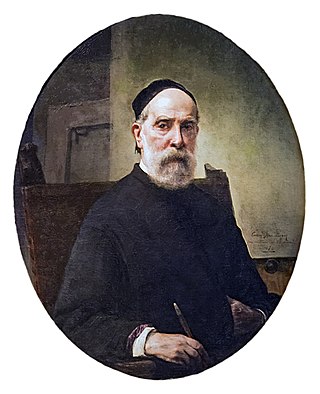Related Research Articles

Luca Giordano was an Italian late-Baroque painter and printmaker in etching. Fluent and decorative, he worked successfully in Naples, Rome, Florence, and Venice, before spending a decade in Spain.

Oswald Achenbach was a German painter associated with the Düsseldorf school of painting. Though little known today, during his lifetime he was counted among the most important landscape painters of Europe. Through his teaching activities, he influenced the Kunstakademie Düsseldorf. His brother, Andreas Achenbach, who was twelve years older, was also among the most important German landscape painters of the 19th century. The two brothers were humorously called "the A and O of Landscapes".

Francesco Hayez was an Italian painter. He is considered one of the leading artists of Romanticism in mid-19th-century Milan, and is renowned for his grand historical paintings, political allegories, and portraits.

Sir Charles Lock Eastlake was a British painter, gallery director, collector and writer of the 19th century. After a period as keeper, he was the first director of the National Gallery. From 1850 to 1865 he served as President of the Royal Academy, succeeding Martin Archer Shee in the role.

Egide Charles Gustave, Baron Wappers was a Belgian painter. His work is generally considered to be Flemish and he signed his work with the Dutch form of his name, Gustaaf Wappers.
Robert Alexander Hillingford was an English painter. He specialized in historical pictures, often battle scenes.

William Collins was an English landscape and genre painter. His sentimental paintings of poor people enjoying nature became a posthumous high fashion, notably in the 1870s when his market price rose higher than Constable and stayed so until 1894. Turner, his model, far exceeded him in value.

Domenico Morelli was an Italian painter, who mainly produced historical and religious works. Morelli was immensely influential in the arts of the second half of the 19th century, both as director of the Accademia di Belle Arti in Naples, but also because of his rebelliousness against institutions: traits that flourished into the passionate, often patriotic, Romantic and later Symbolist subjects of his canvases. Morelli was the teacher of Vincenzo Petrocelli, Ulisse Caputo, and Anselmo Gianfanti.

Thomas Fearnley was a Norwegian romantic painter, a pupil of Johan Christian Dahl and a leading representative of Norwegian romantic nationalism in painting. His son Thomas Fearnley (1841–1927) founded the Fearnley dynasty of shipping magnates.

Georg Hilker was a Danish decorative painter active during the Danish Golden Age in the first half of the 19th century. He collaborated with painter Constantin Hansen (1804–1880).

James John Wilson Carmichael, also known as John Carmichael was a British marine painter.

Isidore-Alexandre-Augustin Pils (1815–1875) was a French academic painter of religious and military subjects.

Eduardo Dalbono was an Italian painter born in Naples.

Consalvo Carelli was an Italian landscape painter and painter of the School of Posillipo. He is also known as Gonsalvo Carelli.

Filippo Marsigli was an Italian painter in the Neoclassic style. He specialized in large canvases on epic, historical subjects.
Oreste Recchione was an Italian painter, mainly of landscapes but also of religious and mythologic paintings.

Federigo or Federico Rossano was an Italian painter in a Realist style.

Raffaele Armenise was an Italian painter and scenographer, mainly painting history and genre subjects.
Raffaele Mattioli was an Italian painter, active in his native Naples.
Chen Ruo Bing is a Chinese artist whose abstract color painting merges Eastern tradition and Western contemporary art.
References
- ↑ Meleleo.com, short biography.
- ↑ Annali civili del Regno delle due Sicilie, entry of Ruo for 1841 exhibition, page 142.